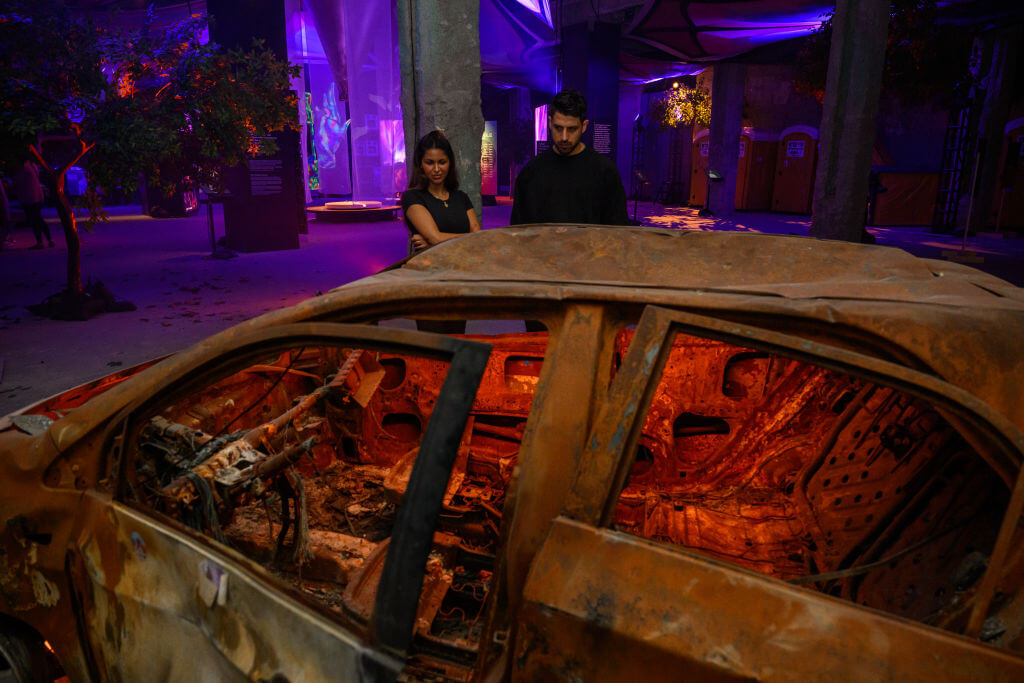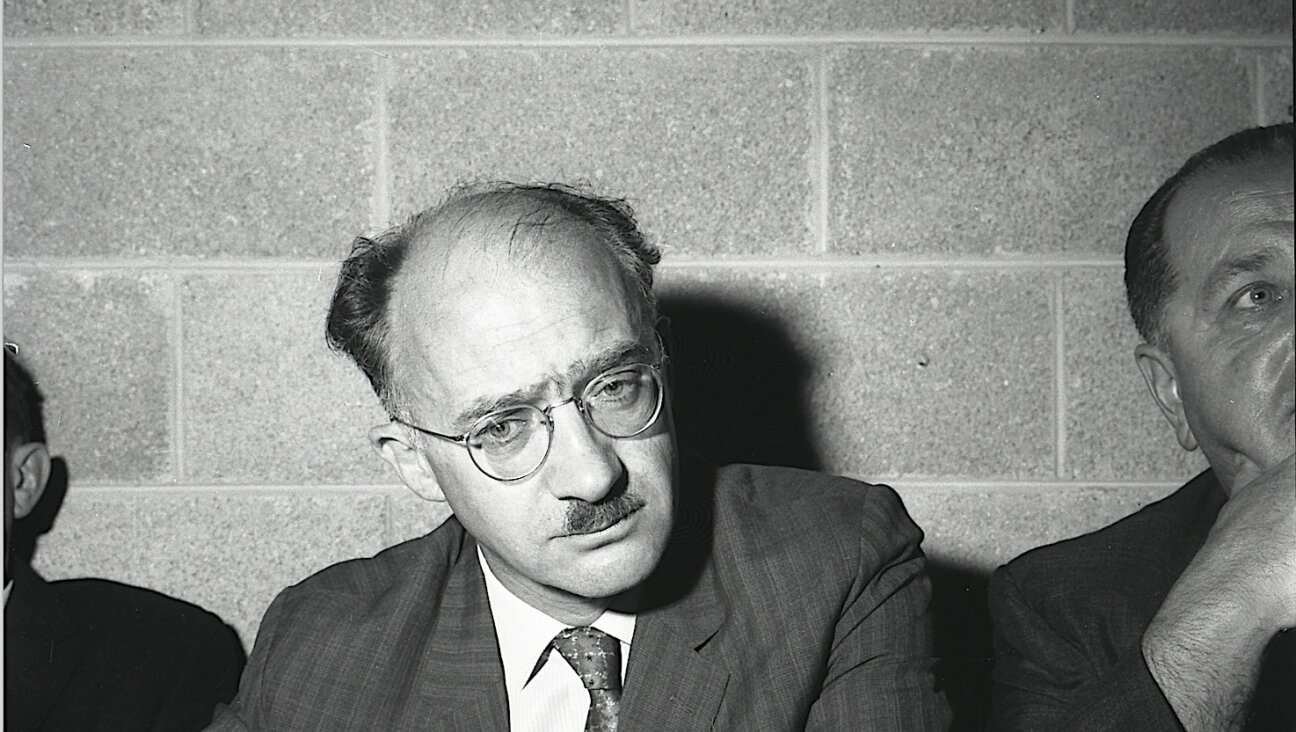What I told my children when our synagogue was graffitied with a swastika
“This is the complicated, real truth of what it means to be Jewish in America right now,” writes a mother and rabbi’s wife from suburban Philadelphia

Graphic by Midjourney
WYNNEWOOD, Pennsylvania (JTA) — On Saturday night, I watched an episode of “We Were the Lucky Ones,” Hulu’s new Holocaust series. On Sunday morning, I woke up to a traumatic scene in my own community: a red swastika painted on the banner that sits on the front lawn of the suburban Philadelphia synagogue where my husband is the rabbi.
Even though it wasn’t shattered glass, or broken bones, it was painful to see it there, right there, in our own backyard, on our property, on our beloved banner that advertises our early childhood program and the summer camp my children will attend. It was vandalism, an ugly symbol that has only one meaning for generations: Jews, you are hated. Jews, you are not welcome. Jews, you should be afraid.
My husband and his committee of leaders and professionals from the synagogue, Temple Beth Hillel-Beth El, sprang into action in response. I left on a planned hike with my children, ages 4 and 7, keeping them away from the news vans and police cars that occupied the parking lot of their school and synagogue.
I knew what was unfolding back at the synagogue was notable. On Easter, our police came to investigate, Christian clergy called to support us and spoke at our vigil and prayer service, and politicians all reached out — from our state senator to our congressman to Gov. Josh Shapiro. It was a miraculous response when you consider the arc of Jewish history, when Jews have often felt alone in the face of so much persecution, oppression and violence, especially on Christian holidays.
But it wasn’t until I answered my children’s questions that I felt comforted.
They asked, “Where is Abba? Why has he been gone all day?” Here’s what I answered:
Abba is gone because he is taking care of our community and helping everyone feel safe and feel better, because right now they are sad. Someone — we don’t know who — drew a picture on the blue sign and it’s a picture that represents a way of being mean to Jews and hating Jews and when Jewish people see the picture, it makes them feel sad because it reminds them that there are some people in the world who hate Jews.
They asked: “Why do some people in the world hate Jews?”
I answered: Jews as a people have been around for thousands of years and as long as there have been people, people have been hating other people for being different. Being with people who are just like us makes us feel safe, and sometimes when we see someone who is different, or go somewhere new, we feel afraid. And we don’t like to feel afraid, so we tell ourselves a story about our fear — that the other people must be bad. And that reason isn’t true, because those people aren’t all bad: Every person makes good choices and bad choices, but all people are just people making choices every day, just like us.
But some of the things that people don’t like about Jews is that we do different things and we like to stay different. Some Jews wear different clothes, some eat their own special food, we like to celebrate our holidays at a specific time and even when some Jews like to share our special traditions, sometimes it takes a lot of work to understand what they mean. So as long as there have been Jews, there has been something called antisemitism, which is a word that specifically means hatred of Jewish people. And the people who perhaps hated Jews the most were called the Nazis, and they lived a long time ago in Germany, where they used the same picture they painted on our banner to inspire other people to hate Jews also.
Today, you are safe. You are not in any danger because you are Jewish. We live here in America, where Jews have never been safer or freer in the whole history of being Jewish. The governor of Pennsylvania himself is a proud, practicing Jew who sends his children to Jewish day school and celebrates being Jewish and is proud of representing his country through his service to his state. The police take care of us when we are hurt. You can go to school where there are Muslims, and Christians, and people of color who are Jewish and similar to you and different from you, and on most days we all get along. It is rare and it is a big deal that someone draws a hateful picture, and the reason we make a big deal out of it is that we want to teach and show everyone that this picture means something hateful, and you can’t draw it anywhere.
But since the war in Israel, more and more people are drawing these pictures, and writing words in graffiti, and protesting Jewish-owned businesses and Israeli embassies because of the war between the Israelis and the Palestinians. And while we don’t know this for sure, it’s likely that the person drew the hateful symbol on our banner because it was talking about Israel. The banner says, “Our community stands with Israel.” And this is true. Our community stands by the people of Israel, the right of the Jewish people to have a homeland in their ancient home, the right of Jews to live free from persecution and oppression, the right of Jews to feel safe and secure, the right of Jews to protect themselves, the right of all citizens of Israel — Jews and Christians, Arab and Druze — who fight for a free and democratic Israel.
The symbol that they drew does not say what we also believe: that Palestinians should live freely and safely, that all people deserve a life of liberty and self-determination, that a bloody and horrible war should end with the return of those who were taken hostage, and peace should come to both peoples, neither of whom will go anywhere but deserve to live in peace side by side. This is what the majority of us want and hope for and if the sign were big enough, that’s what it should have said.
Abba wrote to our community, “A swastika is not a commentary on the policies of the State of Israel, nor is it a sign of solidarity with Palestinians. It is a symbol of hatred and division. We, the leadership of the synagogue, want everyone to know that we will not give in to fear or division.”
Abba does not want us to be afraid and he does not want us to be alone. When someone hurts our feelings, we teach them what they can do to repair and make it better. We do not give up on our friends, we believe in them, and we reach out to them, and we work together, so that we can all live peacefully and safely side by side.
And today made us feel sad, I said, but we are not going to stop being proud of being Jewish. It’s some of the best parts of who we are.
By that point, I had completely lost my children’s attention; they went back to playing with their friends on the playground. And it was unclear how much of that they understood or how many lingering worries they will have about their safety and their place in this world. But I felt better having said it — safer, still sad, but more at peace — because I knew, as soon as the words left my mouth, that this is the complicated, real truth of what it means to be Jewish in America right now and for better or worse, being Jewish in America means days like this.
This article originally appeared on JTA.org.















